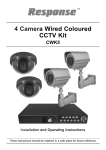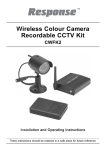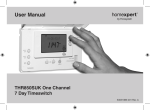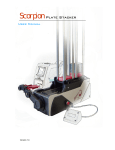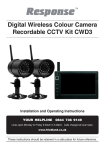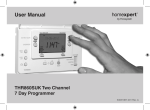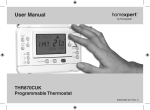Download Response CWFK1/CA3 Operating instructions
Transcript
Wireless Colour Camera CCTV System CWFK1 / CA3 Installation and Operating Instructions These instructions should be retained in a safe place for future reference. CONTENTS 1 INTRODUCTION 3 4.3 Setting the Camera Channel (Optional) 9 2 KIT CONTENTS 4 4.4 Setting the Receiver Channel (Optional) 10 3 INSTALLATION 5 4.5 Night Vision 10 4.6 Camera and Interference 10 3.1 3.2 3.3 Direct Connection of the Receiver to the TV 5 Connection of the Receiver to a VCR / DVR 6 Wireless Camera Installation 4 VIEWING THE CAMERA 5 TROUBLESHOOTING 12 7 6 TECHNICAL SPECIFICATION 13 8 7 ACCESSORIES IN THE RANGE 14 4.1 Viewing the Wireless Camera from the Receiver connected directly to a TV 8 8 DISPOSAL AND RECYCLING 15 4.2 Viewing and Recording the Wireless Camera on a VCR or DVR 8 9 GUARANTEE AND CUSTOMER HELPLINE 16 Please read before you start: Always use discretion when installing CCTV surveillance equipment especially when there is perceived policy. Enquire regarding local regulations applicable to the lawful installation of video recording / surveillance. Third party consent may be required. 2 INTRODUCTION Section 1 The Response Wireless Colour Camera CCTV System is a monitoring system designed to help protect your home or office. SAFETY AND INSTALLATION TIPS: Do not attempt to open the units with the power adaptor plug connected to avoid any risk of personal injury. When installing CCTV camera(s), always follow manufacturer’s advice when using power tools, steps, ladders, etc. and wear suitable protective equipment (e.g. safety goggles) when drilling holes. Before drilling holes through walls check for hidden electricity cables and water pipes. The use of a cable/pipe detector is advisable. When installing the wireless camera(s) on an external wall, pass the power cable through the wall as close as possible to the camera to prevent/reduce the chances of the cables being tampered with. After drilling any hole though an external wall for cable(s), ensure the hole is sealed up around the cable using a sealant to prevent drafts. To prevent a fire or electrical shock hazard, do not attempt to open the housing while the unit is exposed to rain, water or wet conditions. There are no user serviceable parts inside. Refer servicing to qualified service personnel. DEVICE OPERATING RANGE: The wireless camera is capable of transmitting up to 100m in open field conditions. However, when installed around your property, any solid objects (e.g. walls, ceiling, reinforced PVC doors, etc.) placed between the camera and receiver will reduce the range. For best transmission, avoid installations where there are very thick walls or major obstructions between the wireless camera and receiver. Avoid installing the camera or receiver next to a metal radiator, wireless router, or microwave oven. If at any stage this kit is used with a Digital Video image Recorder (DVR) to record / viewed video on the TV, ensure the signal reception is the best possible reception (i.e, no interference lines viewed on the TV) between the camera and receiver. If necessary reduce the distance between the camera and receiver to prevent any interference on the picture. This is important to prevent the DVR from capturing any unnecessary recordings of interference when set to motion record. You may find that if the wireless camera is installed outside the property, the maximum operating range without interference may be no more than 10m (provided only single brick wall acts as a barrier between the camera and receiver). 3 KIT CONTENTS Section 2 CWFK1: 1 x Wireless Colour Camera 1 x Wireless Receiver unit 1 x Video output cable for wireless receiver to TV 1 x Wireless Camera power supply adaptor (12VDC/300mA) 1 x Wireless Receiver power supply adaptor (12VDC/300mA) 1 x Camera fixing kit - wall plugs and screws 1 x Window stickers 1 x Installation and operating manual CA3: 1 x Wireless Colour Camera 1 x Wireless Camera power supply adaptor 1 x Camera fixing kit - wall plugs and screws 1 x Window sticker 1 x Installation and operating manual Tools Required: Electric drill 5mm masonry drill bit 15mm masonry drill bit No. 2 Philips screwdriver 3mm flat blade screwdriver 4 INSTALLATION Section 3 3.1 Direct Connection of the Receiver to the TV TV / MONITOR WIRELESS RECEIVER DC12V POWER VIDEO AV Input Yellow Connector (VIDEO) DVRs Power Supply Adaptor INPUT 1 INPUT 2 1. Connect the video cable and power adaptor’s output plug into the receiver. 2. Connect the video cable to the RCA video input on the TV. 3. Plug the power adaptor into the mains socket (240VAC) and switch ON. 5 OUTPUT 3.2 Connection of the Receiver to a VCR / DVR WIRELESS RECEIVER DC12V POWER VIDEO TV / MONITOR DVRs Power Supply Adaptor AV Input Yellow Connector (VIDEO) VIDEO CONNECTIONS ON VCR/DVR INPUT 1 INPUT 2 INPUT OUTPUT Video Cable (Not Supplied) 1. Connect the video cable and power adaptor’s output plug into the receiver. 2. Connect the other end of the supplied video cable into the RCA video INPUT on the VCR / DVR. 3. Plug the power adaptor into the mains socket (240VAC) and switch ON. 6 OUTPUT 3.3 Wireless Camera Installation Mount the camera in a selected location using the fixing screws and plugs supplied. If the camera is installed outdoors on an external wall you will need to drill a cable entry hole of around 15mm for the cable to pass through the wall. Feed the camera’s cable through the cable entry hole into the property, so that all connections are made inside. Ensure that there is a mains power socket internally located near to the camera for power. After installing the camera, seal the cable hole using a suitable sealant to prevent drafts. 2.4 GHz Weather-proof HORIZONTAL SURFACE MOUNT Loosen this nut by hand and unscrew the bracket if ceiling mounting is desired Bracket WALL MOUNT Note: in this mounting position, the Camera body needs to be slightly tilted to prevent the antenna from touching the wall CEILING MOUNT 2.4 GHz Weather-proof 7 The sun shade hood can be removed from the camera body and re-attached for installation flexibility. This is done by sliding along the body of the camera as shown. 2.4 GHz Weather-proof VIEWING THE CAMERA Section 4 4.1 Viewing the Wireless Camera from the Receiver connected directly to a TV 1. Connect the camera and receiver as described in ‘Direct Connection of the Receiver to the TV’ on page 5. 2. Power up the receiver and camera. 3. Turn ON your TV. 4. Select the correct A/V channel on the TV until the image from the camera can be viewed. If you are unable to change the input on your TV, consult the TV’s instruction manual or contact the TV’s manufacturer. 4.2 Viewing and Recording the Wireless Camera on a VCR or DVR 1. Connect the camera and receiver as described in the ‘Connection of the Receiver to a VCR / DVD Recorder’ on page 6. 2. Power up the receiver and camera. 8 3. Turn ON your TV and VCR or DVR. 4. Playback a tape on the VCR or recorded video on the DVR to confirm your TV is on the correct channel. 5. Tune the input viewing channel of the VCR or DVR until your camera appears on screen. If you are unable to tune the VCR or DVR, consult the VCR / DVR instruction manual or contact its manufacturer *. * To tune the TV or VCR / DVR to view the camera, press the button associated with, Source, Line In, L1, L2, AUX, A / V, channel 0 etc. Consult the TV or VCR / DVR instruction manual for details about changing the input channel on the device. Note: By default the camera and receiver will be set to channel 1. If poor reception is received by any camera set to a specific channel and adjusting the orientation of the receiver’s antenna doesn’t help, then set the camera to another unused channel. See below. 4.3 Setting the Camera Channel (Optional) The wireless camera has 4 selectable channels to avoid any interference from any other wireless devices. Follow the steps below to set or change the frequency channel of the camera. If you are adding another camera to an existing system, then ensure it’s channel is set to a different channel to the existing camera(s). 1 2 1. Pull open the rubber flap on the camera’s power cable. 2. Locate the 2 dip switches under the rubber flap. 3. Set the camera channel as per the switch configuration below using the DIP switch tool provided. Do not set multiple cameras on the same channel or interference may appear on screen. Channel 1 Channel 2 Channel 3 Channel 4 DIP Switch Tool 1 2 1 2 1 2 1 2 Note: It is possible to link up to 4 wirefree cameras to the receiver; however you may need to adjust the orientation of the antenna on the receiver depending on the reception of the channel being viewed. 9 4.4 Setting the Receiver Channel (Optional) The wireless receiver is capable of receiving up to 4 separate channels. The front of the wireless receiver has 4 LEDs representing the 4 channels of the receiver. When lit, the LED will indicate which channel is currently being displayed. In the diagram below CH1 is lit up indicating channel 1 will be displayed on the screen. The wireless receiver allows you to manually switch between active channels by pushing the SET button. (The orientation of the channels when pressing the ‘SET’ button each time is CH1 to CH2 to CH3 to CH4 and back to CH1). Channel SET Button CH1 CH2 CH3 CH4 SET Channel Indicator Lights 4.5 Night Vision The Camera has built-in Infra-red LEDs to allow you to view up to a distance of 7m at night for 24hrs surveillance. The LEDs will automatically activate at night and the picture viewed will turn to black and white. 4.6 Camera and Interference The wireless camera operates on the 2.4GHz frequency. Some devices such as wireless broadband routers, microwaves, cordless phones can cause interference and affect picture quality as they use the same frequency. If you are experiencing interference or poor image quality try the following steps: - move or orient the camera in a different location. - adjust the receiver’s antenna. - limit the number of walls, floors between the camera and receiver as this can dramatically alter picture quality. 10 - dense materials such as concrete or metal will impede the wireless signal; move the camera and/or receiver away from dense materials. A metal radiator is an example. - if possible keep the camera and receiver away from or move conflicting devices such as wireless routers, microwaves, cordless phones. - make sure all Cameras are set to different channels. - disconnect all other wireless devices to find out which is causing the problem and adjust your setup accordingly. - some wireless signals may originate from nearby homes or businesses; in this case a wired camera may be necessary. - if using the wireless camera kit with a DVR which is set to motion record, ensure that the best possible reception can be viewed from the wireless camera. If necessary move the camera closer to the receiver to prevent any interference from being viewed. Interference will cause the DVR to trigger and record the interference unnecessarily. 11 TROUBLE SHOOTING Section 5 PROBLEM SOLUTION I can’t see the Camera Ensure the camera and receiver are plugged in. on my TV and the TV / VCR / DVR is tuned to the correct input channel as described on page 9. A white image appears at night The camera’s infra-red LEDs shine invisible light that reflects of surfaces such as glass causing white light. Place the camera on the other side of windows or place the lens flush against the surface to try to improve the night vision or place in a well lit area. I keep getting interference The wireless camera operates on the 2.4GHz in my home or business frequency like many devices such as wireless routers, cordless phones, and microwaves. If possible keep the camera(s) and receiver away from these devices. 12 TECHNICAL SPECIFICATION Section 6 ITEM WIRELESS CAMERA Image sensor 1/3” CMOS Pixel resolution PAL: 628 x 582 NTSC: 510 x 492 380 TV lines Lens size 6mm Viewing angle 60° Night vision range Up to 7m Number of infra-red LEDs 11 Day / night mode Colour during the day / switches to B&W at night Minimum illumination 5 Lux when the IR lamps are turned on Signal Analogue Maximum transmission range 100m (open field range) Operating frequency 2.4000 GHz – 2.4835 GHz Channels 4 IP rating IP54 Operating temperature - 10°C to 50°C Power supply 12 VDC / 300mA Dimensions (H x W x D) 102 x 52 x 102mm Weight 214g ITEM WIRELESS RECEIVER Operating frequency 2.4000 GHz – 2.4835 GHz Channels 4 Signal Analogue IP rating IP40 - Internal use only Video NTSC / PAL Power supply 12V DC/1.2A output power supply adaptor Video output interface RCA sockets 13 ACCESSORIES IN THE RANGE Section 7 There are a range of accessories available in the Response CCTV product range to expand your system: CWK1 Wired Colour Camera CCTV Kit CA1 2 Channel Digital Video Image Recorder CA2 LCD Screen for Wireless / Wired CCTV Kits CA3 Wireless Colour Accessory Camera (requires CWFK1 CCTV KIT to operate) CA5 Professional Heavy Duty Camera CCTV Kit CA6 Dummy Professional Heavy Duty Camera CA7 4 Channel DVR Recorder Kit CA8 Wired Internal Colour Dome Camera CCTV Kit CA9 Dummy Internal Dome Camera CA10 Heavy Duty Colour Camera CCTV Kit CA11 Dummy Heavy Duty Camera CA4 10m Extension Cable Kit CA12 20m Extension Cable Kit Note: The maximum extension cable length for any wired camera with this system is 30m without reducing the picture quality of the video. 14 DISPOSAL – RECYCLING INSTRUCTIONS Directive (2002/96/EC) This product is classified by the Waste Electrical or Electronic Equipment (WEEE) Directive. It should not be disposed of with other household or commercial waste. At the end of its useful life the packaging and product should be disposed of via a suitable recycling centre. For information on available facilities, please contact your local authority or the retailer from where the product was purchased. 15 Section 8 GUARANTEE Section 9 Novar ED&S undertakes to replace or repair at its discretion goods (excluding non rechargeable batteries) should they become defective within 1 year solely as a result of faulty materials and workmanship. If the product has not been installed, operated or maintained in accordance with the instructions, has not been used appropriately or if any attempt has been made to rectify, dismantle or alter the product in any way the guarantee will be invalidated. The guarantee states Novar ED&S entire liability. It does not extend to cover consequential loss or damage or installation costs arising from the defective product. This guarantee does not in any way affect the statutory or other rights of a consumer and applies to products installed within UK and Eire only. If an item develops a fault, the product must be returned to the point of sale with: 1. Proof of purchase. 2. A full description of the fault. 3. All relevant batteries (disconnected). Response is a trademark of Novar ED&S. CUSTOMER HELPLINE Most issues can be solved over the phone in a few minutes. Please contact our Helpline Team on the number below for any installation and general advice regarding our products: 0844 736 9149 Lines open 9.00am to 5.00pm, Monday to Friday. Calls charged at service providers national rate. Novar Electrical Devices and Systems Limited. (A Honeywell Company) The Arnold Centre, Paycocke Road, Basildon, Essex SS14 3EA. UK www.friedland.co.uk © Novar Electrical Devices and Systems Limited. 2009 50043919 Rev.B
















